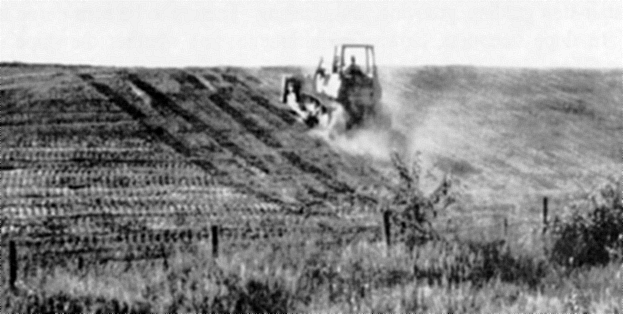 |
 |
To Print Use The pdf File
ILLINOIS URBAN MANUAL
PRACTICE STANDARD
SURFACE ROUGHENING
(acre or sq ft)
CODE 953
 (Source:VA Erosion and Sediment Control Handbook) |
DEFINITION
A rough soil surface with horizontal grooves running across the slope on the contour, stair stepping, or tracking with construction equipment.
PURPOSE
The purposes of this practice are to aid in the establishment of vegetative cover from seed, reduce runoff velocity, increase infiltration, reduce erosion, and provide for sediment trapping.
CONDITIONS WHERE PRACTICE APPLIES
Areas that have been graded and are to be stabilized with vegetation established by seed without use of an erosion control mat.
Areas that have been graded and will not be permanently stabilized immediately.
Slopes with a stable rock face do not require roughening or stabilization.
CRITERIA
All slopes steeper than 3:1 (horizontal to vertical) shall be surface roughened by either stair-step grading, grooving, or tracking.
Areas with slopes flatter than 3:1 shall have the soil surface lightly roughened and loosened to a depth of 2 to 4 inches prior to seeding.
Stair-step grading shall consist of cutting a slope into stair steps. Each step shall have a vertical cut depth to horizontal step length of less than 1:1. The horizontal portion of the step shall slope toward the vertical wall. Individual vertical cuts shall not be more than 30 inches on soft materials and not more than 40 inches in rocky materials.
Grooving shall consist of using machinery to create a series of ridges and depressions that run perpendicular to the slope (on the contour). Grooves shall not be less than 3 inches deep nor further than 15 inches apart except for areas that will be mowed where the grooves shall not be less than 1 inch deep nor further than 10 inches apart.
Tracking shall consist of surface roughening with tracked machinery. Tracking shall only be used on course texture or relatively dry, finer-texture soils to avoid compaction of the soil. The tracked machinery shall be operated up and down the slope to leave horizontal depressions in the soil. Back-blading shall not be permitted during the final grading operation. The number of machinery passes shall be limited to minimize soil compaction.
All surface roughened areas shall be seeded and mulched as soon as possible to obtain optimum seed germination and seedling growth. Seeding and mulching shall be completed in accordance with practice standards MULCHING 875, PERMANENT VEGETATION 880, or TEMPORARY SEEDING 965, as appropriate.
Fill slopes that are surface roughened by allowing the surface to remain rough as the fill is placed and compacted shall have a loose uncompacted surface depth of 4 to 6 inches.
CONSIDERATIONS
Rough slope surfaces are preferred because they aid in the establishment of vegetation, improve water filtration, and decrease runoff velocity. Graded areas with smooth, hard surfaces may be initially attractive, but such surfaces increase the potential for erosion. A rough, loose soil surface gives a mulching effect that protects lime, fertilizer and seed. Nicks in the surface are cooler and provide more favorable moisture conditions than hard, smooth surfaces; this aids seed germination.
There are different methods for achieving a roughened soil surface on a slope, and the selection of an appropriate method depends upon the type of slope. Factors to be considered in choosing a method are slope steepness, mowing requirements, and whether the slope is formed by cutting or filling.
Stair-step grading may be carried out on any material soft enough to be ripped with a bulldozer. Slopes consisting of soft rock with some subsoil are particularly suited to stair-step grading.
Grooves may be made with any appropriate implement that can be safely operated on the slope and which will not cause significant compaction. Suggested implements include offset discs, tillers, spring harrows, chisel rippers, and the teeth on a front-end loader bucket.
For areas that will be mowed, surface roughening should consist of shallow grooves created by normal tilling, disking, harrowing, or use of a culti-packer seeder. The final pass of any such implement shall be on the contour.
Tracking is generally not as effective as the other roughening methods described since the soil surface is more likely to be compacted which results in less infiltration of runoff.
PLANS AND SPECIFICATIONS
Plans and specifications for surface roughening shall be in keeping with this standard and shall describe the requirements for applying the practice to achieve its intended purpose. At a minimum include the following items:
All plans shall include installation, inspection, and maintenance schedules with the responsible party identified.
OPERATION AND MAINTENANCE
The slope shall be inspected after every runoff producing rain and repairs made as needed. Fill any eroded areas to slightly above the original grade, re-roughen the surface, then re-seed and mulch as soon as possible.
REFERENCES
North Carolina Sedimentation Control Commission, 1988. Erosion and Sediment Control Planning and Design Manual. NC
Virginia Department of Conservation and Recreation, Division of Soil and Water Conservation, 1992. Virginia Erosion and Sediment Control Handbook, 3rd ed., VA
NRCS IL November 1999